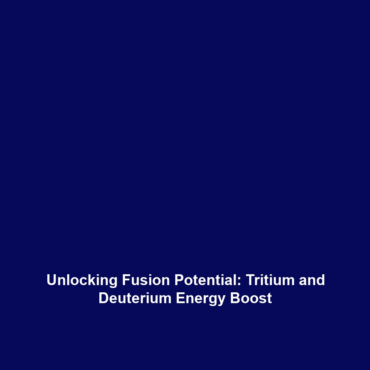Fusion Power Plants: A Key to Stable and Continuous Electricity
Introduction:
In the transition towards a sustainable energy future, fusion power plants emerge as a promising solution capable of providing stable, continuous electricity. Unlike traditional energy sources, fusion energy offers the potential to complement intermittent renewable sources, such as solar and wind, thereby significantly enhancing grid reliability. Understanding the significance of fusion power plants within the broader context of Fusion Energy is essential for grasping their potential impact on global energy security and environmental sustainability.
Key Concepts
Fusion power operates on the principle of fusing atomic nuclei to release massive amounts of energy. Here are the major concepts related to fusion power plants:
- Nuclear Fusion: The process where two light atomic nuclei combine to form a heavier nucleus, releasing energy in the process.
- Plasma State: Fusion reactions require extremely high temperatures, creating a state of matter called plasma, where electrons are separated from nuclei.
- Magnetic Confinement: This technique uses powerful magnetic fields to contain the plasma, preventing it from coming into contact with any material surfaces.
These principles all connect to the concept of Fusion Energy, emphasizing the reliability and stability that fusion power plants could offer to the energy grid.
Applications and Real-World Uses
The practical applications of fusion power plants span various sectors. Notably:
- Energy Generation: Fusion power could result in large-scale, reliable electricity generation, making it a viable alternative to fossil fuels.
- Complementing Renewables: By providing a stable base load power, fusion can support renewable energy sources during periods of low output.
- Desalination and Hydrogen Production: Fusion energy could also be harnessed for industrial processes, contributing to water desalination and hydrogen fuel production.
These applications showcase how fusion power plants can redefine energy generation within the framework of Fusion Energy.
Current Challenges
Despite its promise, several challenges hinder the development and deployment of fusion power plants and their reliable electricity output:
- Technical Challenges: Achieving and maintaining the extreme conditions necessary for fusion has proven difficult.
- Economic Viability: High initial investment and ongoing operational costs present significant hurdles.
- Long Development Timelines: Research and infrastructure take time to develop, delaying potential benefits of fusion energy.
Addressing these challenges is crucial for the advancement of fusion energy technology in the energy sector.
Future Research and Innovations
Ongoing research in fusion technology is yielding promising innovations that may enhance the efficacy of fusion power plants:
- Tokamak Advancements: New designs and materials aim to improve plasma confinement stability.
- Inertial Confinement Fusion: Research is exploring methods that use lasers for increased efficiency in fusion reactions.
- Net Energy Gain: Achieving a state where the energy produced exceeds the energy consumed is the ultimate goal of fusion research.
Investments and breakthroughs in these areas are set to play pivotal roles in the future of Fusion Energy, promising a reliable and abundant energy source.
Conclusion
Fusion power plants could provide a crucial solution for stable, continuous electricity, significantly augmenting the reliability of energy grids alongside renewable sources. Their development represents a vital opportunity in the quest for sustainable energy. As research progresses, stakeholders should prioritize investments in fusion technology to unlock its full potential. To learn more about renewable energy and its innovations, explore our insightful articles on various energy solutions.









